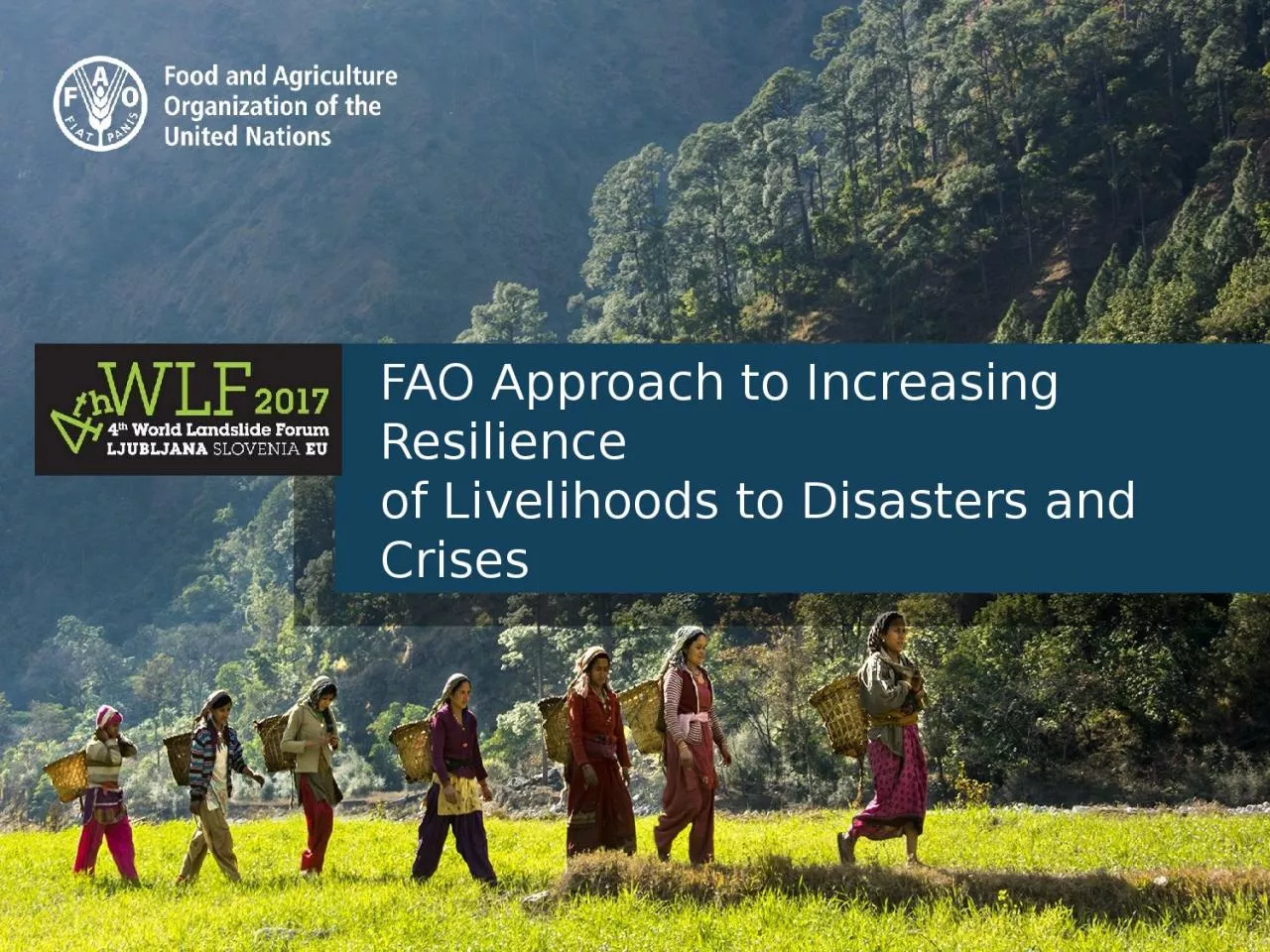

of Livelihoods to Disasters and Crises Number of deaths by disaster types 1996 2015 From Poverty amp Death Disaster Mortality httpemdatbe Floodslandslides impacts better controlled ID: 1021005
Download Presentation The PPT/PDF document "FAO Approach to Increasing Resilience" is the property of its rightful owner. Permission is granted to download and print the materials on this web site for personal, non-commercial use only, and to display it on your personal computer provided you do not modify the materials and that you retain all copyright notices contained in the materials. By downloading content from our website, you accept the terms of this agreement.
1. FAO Approach to Increasing Resilience of Livelihoods to Disasters and Crises
2. Number of deaths by disaster types1996 - 2015From: Poverty & Death: Disaster Mortality, http://emdat.be/
3. Floods/landslides impacts better controlled: population affected, 1990 - 2016
4. Drought impacts persist: Population affected, 1990 - 2016
5. Prevention - move words into actionFrom disaster management to risk reduction management and risk informed developmentDRR - a development issue; integrate into SDGs; deliver through sectoral workImportance of agriculture sectors to DRR delivery (agriculture risk reduction measures are cost-effective) Multi-hazard perspectiveInsurance and risk transfer – key pillars of comprehensive risk managementSystematic data incl. remote sensing – basis for planningKey Messages Recap: from Cancun to LjubljanaFAO Approach to increasing Resilience of Livelihoods to Disasters and Crises
6. FAO strategic objectives1. Help eliminate hunger, food insecurity and malnutrition 2. Make agriculture, forestry and fisheries more productive and sustainable 3. Reduce rural poverty4. Enable inclusive and efficient agricultural and food systems 5. Increase the resilience of livelihoods to threats and crisesFAO Approach to increasing Resilience of Livelihoods to Disasters and Crises
7. Natural disastersFood chain emergenciesSocio-economic crisesViolent conflictsProtracted crisesFAO focuses on specific hazards, risks and relatedvulnerabilities of agriculture, food and nutritionFAO Approach to increasing Resilience of Livelihoods to Disasters and Crises
8. Resilience in FAO’s strategic frameworkSO5 Increase the resilience of livelihoods to threats and crisesSO1 Eradicate hunger, food insecurity and malnutritionSO2 Increase and improve provision of goods and services from agriculture, forestry and fisheries in a sustainable mannerSO4 Enable more inclusive and efficient food and agricultural systems at local, national and international levelsSO3 Reduce rural povertyGlobal Goal:Reduction of hunger and malnutritionSustainable management of natural resourcesElimination of poverty through economics and social progressResilience in terms of sustainable production and agroecosystem stressesResilience as an institutional condition for reducing hungerResilience in terms of social poverty dimensionResilience in terms of market and food chain dimensionResilience to stressesResilience to shocksVision: World free from hunger and malnutritionFAO Approach to increasing Resilience of Livelihoods to Disasters and Crises
9. GOVERN RISKS AND CRISES: Institutional strengthening and risk and crisis management governance for agriculture, food and nutrition WATCH TO SAFEGUARD:Information and early warning systems for agriculture, food and nutrition and transboundary threatsPREPARE AND RESPOND TO CRISES:Preparedness and response to crisis affecting agriculture (including livestock, fisheries, aquaculture and forestry), food and nutrition7 Core Functions: Standards, Information management, Policy dialogue, Capacity development, Knowledge management, Strategic partnerships, CommunicationCross-cutting themes: Governance, Gender, Statistics, Climate ChangeIncrease resilience of livelihoods to shocksApply risk and vulnerability reduction measures:Protection, prevention, mitigation and building livelihoods with technologies, approaches and good practices for agriculture, food and nutrition Resilience: four outcomesFAO Approach to increasing Resilience of Livelihoods to Disasters and Crises
10. Example of Outcome:Countries reduce risks and vulnerability at household and community levelExamples:Agroforestry: Trees can be used as shelterbelts and windbreaks. They can stabilize riverbanks, mitigate soil erosion, protect against landslides and floods.Rainwater harvesting: Technologies & practices that use less water, reduce water loss, and increase overall water productivity during droughts.Conflict sensitive measures: Tenure, access to natural resources (water, land, trees, pasture, transhumance routes, …)FAO Approach to increasing Resilience of Livelihoods to Disasters and Crises
11. Project Example: Nepal Post-Earthquake Response FAO Approach to increasing Resilience of Livelihoods to Disasters and Crises
12. From short-term response to long-term rehabilitation and resilienceEarthquake as an opportunity to “build back better”Combine slope stability with NRM and livelihood improvementWatershed management approach!Project StrategyFAO Approach to increasing Resilience of Livelihoods to Disasters and Crises
13. 1. Landslide risk assessment and treatment (2015-2016)Implement emergency response activities related to landslides with immediate benefits2. Landslide stabilization as a component of watershed management in medium-term rehabilitation (2016-2018)Bring people back to their production systems through watershed management - build back better3. Towards long-term preparedness and resilience (2018-2021)Scale up and institutionalize the experiences for long-term resilience to future shock and trends (such as climate change)Project PhasingFAO Approach to increasing Resilience of Livelihoods to Disasters and Crises
14. Tools: Watershed Management PlanFAO Approach to increasing Resilience of Livelihoods to Disasters and Crises
15. Ministry of Forests and Soil ConservationOther Government agenciesICIMODThe Mountain Institute (TMI)IUCNNepal Water Conservation FoundationInternational Consortium on Landslides (ICL)etc.Project Partners FAO Approach to increasing Resilience of Livelihoods to Disasters and Crises
16. Support the Government to implement the Post-Disaster Needs Assessment (PDNA) recommendations for forestry and environmentFrom short-term rehabilitation to long-term resilienceAddress the entire DRM-cycle: response, recovery, mitigation, preparednessResource mobilizationProject LessonsFAO Approach to increasing Resilience of Livelihoods to Disasters and Crises
17. Leveraging Global Partners and AdvocacyUnited Nations voluntary alliance of partnersDedicated to improving the lives of mountain people and protecting mountain environments around the worldEstablished in 2002293 members - governments, IGOs, NGOs, private sectorSecretariat based at FAO in RomeFAO Approach to increasing Resilience of Livelihoods to Disasters and Crises
18. Save the Date: “Mountains under Pressure”11 Dec 2017 - High-Level Conference in RomeCo-hosts: Government of Italy and FAO Invitees: Heads of states and governments, Mountain Partnership members, goodwill ambassadors, UN conventions, IGOs, NGOs, private sector Objectives: Declaration and Call to Action to establish actions and policies to increase resilience in mountainsCoalition of governments of mountainous countries to raise attention in intl negotiationsSustainable Mountain Development agenda to be integrated in 2030 Agenda and Paris Agreement implementation FAO Approach to increasing Resilience of Livelihoods to Disasters and Crises